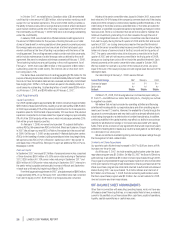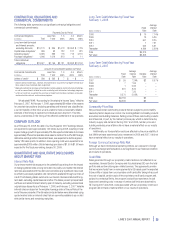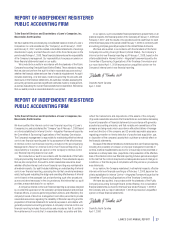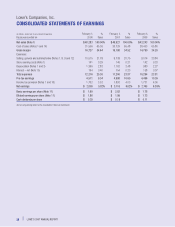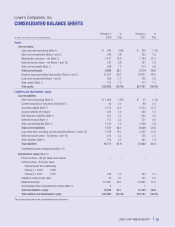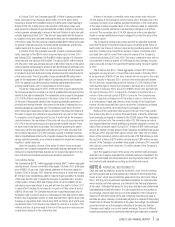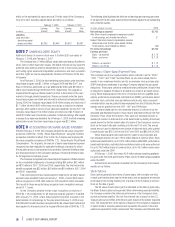Lowe's 2007 Annual Report Download - page 36
Download and view the complete annual report
Please find page 36 of the 2007 Lowe's annual report below. You can navigate through the pages in the report by either clicking on the pages listed below, or by using the keyword search tool below to find specific information within the annual report.
34 |LOWE’S 2007 ANNUAL REPORT
The Company establishes a reserve for tax positions for which there
is uncertainty as to whether or not the postion will be ultimately sustained.
The Company includes interest related to tax issues as part of net interest in
the consolidated financial statements. The Company records any applicable
penalties related to tax issues within the income tax provision.
Revenue Recognition – The Company recognizes revenues, net of sales
tax, when sales transactions occur and customers take possession of the
merchandise. A provision for anticipated merchandise returns is provided
through a reduction of sales and cost of sales in the period that the related
sales are recorded. Revenues from product installation services are recognized
when the installation is completed. Deferred revenues associated with amounts
received for which customers have not yet taken possession of merchandise
or for which installation has not yet been completed were $332 million and
$364 million at February 1, 2008, and February 2, 2007, respectively.
Revenues from stored value cards, which include gift cards and returned
merchandise credits, are deferred and recognized when the cards are
redeemed. The liability associated with outstanding stored value cards was
$385 million and $367 million at February 1, 2008, and February 2, 2007,
respectively, and these amounts are included in deferred revenue in the
accompanying consolidated balance sheets. The Company recognizes
income from unredeemed stored value cards at the point at which redemp-
tion becomes remote. The Company’s stored value cards have no expiration
date or dormancy fees. Therefore, to determine when redemption is remote,
the Company analyzes an aging of the unredeemed cards based on the
date of last stored value card use.
Extended Warranties – Lowe’s sells separately-priced extended warranty
contracts under a Lowe’s-branded program for which the Company is ultimately
self-insured.The Company recognizes revenue from extended warranty sales
on a straight-line basis over the respective contract term. Extended warranty
contract terms primarily range from one to four years from the date of purchase
or the end of the manufacturer’s warranty, as applicable.The Company’s
extended warranty deferred revenue is included in other liabilities (non-current)
in the accompanying consolidated balance sheets.Changes in deferred revenue
for extended warranty contracts are summarized as follows:
(In millions) 2007 2006
Extended warranty deferred revenue,beginning of period $ 315 $ 206
Additions to deferred revenue 175 148
Deferred revenue recognized (83) (39)
Extended warranty deferred revenue, end of period $ 407 $ 315
Incremental direct acquisition costs associated with the sale of extended
warranties are also deferred and recognized as expense on a straight-line
basis over the respective contract term.Deferred costs associated with extended
warranty contracts were $91 million and $81 million at February 1, 2008 and
February 2, 2007, respectively. The Company’s extended warranty deferred
costs are included in other assets (non-current) in the accompanying consoli-
dated balance sheets. All other costs, such as costs of services performed
under the contract, general and administrative expenses and advertising
expenses are expensed as incurred.
The liability for extended warranty claims incurred is included in self-
insurance liabilities in the accompanying consolidated balance sheets. Changes
in the liability for extended warranty claims are summarized as follows:
(In millions) 2007 2006
Liability for extended warranty claims, beginning of period $ 10 $ –
Accrual for claims incurred 41 17
Claim payments (37) (7)
Liability for extended warranty claims, end of period $ 14 $10
Cost of Sales and Selling, General and Administrative Expenses –
The following lists the primary costs classified in each major expense category:
Cost of Sales
• Total cost of products sold, including:
- Purchase costs, net of vendor funds;
- Freight expenses associated with moving merchandise inventories
from vendors to retail stores;
- Costs associated with operating the Company’s distribution network,
including payroll and benefit costs and occupancy costs;
• Costs of installation services provided;
• Costs associated with delivery of products directly from vendors to
customers by third parties;
• Costs associated with inventory shrinkage and obsolescence.
Selling, General and Administrative
• Payroll and benefit costs for retail and corporate employees;
• Occupancy costs of retail and corporate facilities;
• Advertising;
• Costs associated with delivery of products from stores to customers;
• Third-party, in-store service costs;
• Tender costs, including bank charges, costs associated with credit
card interchange fees and amounts associated with accepting the
Company’s proprietary credit cards;
• Costs associated with self-insured plans, and premium costs for
stop-loss coverage and fully insured plans;
• Long-lived asset impairment charges and gains/losses on disposal
of assets;
• Other administrative costs, such as supplies, and travel
and entertainment.
Vendor Funds – The Company receives funds from vendors in the normal
course of business principally as a result of purchase volumes, sales, early
payments or promotions of vendors’ products. Based on the provisions of
the vendor agreements in place, management develops accrual rates by
estimating the point at which the Company will have completed its performance
under the agreement and the amount agreed upon will be earned. Due to the
complexity and diversity of the individual vendor agreements, the Company
performs analyses and reviews historical trends throughout the year to ensure
the amounts earned are appropriately recorded.As a part of these analyses,
the Company validates its accrual rates based on actual purchase trends and
applies those rates to actual purchase volumes to determine the amount of
funds accrued by the Company and receivable from the vendor. Amounts
accrued throughout the year could be impacted if actual purchase volumes
differ from projected annual purchase volumes, especially in the case of
programs thatprovide for increased funding when graduated purchase volumes
are met.
Vendor funds are treated as a reduction of inventory cost, unless they
represent a reimbursement of specific, incremental and identifiable costs
incurred by the customer to sell the vendor’s product. Substantially all of the
vendor funds that the Company receives do not meet the specific, incremental
and identifiable criteria. Therefore, the Company treats the majority of these
funds as a reduction in the cost of inventory as the amounts are accrued
and recognizes these funds as a reduction of cost of sales when the inventory
is sold.
Advertising – Costs associated with advertising are charged to expense as
incurred.Advertising expenses were $788 million, $873 million and $812 million
in 2007, 2006 and 2005, respectively. Cooperative advertising vendor funds
are recorded as a reduction of these expenses with the net amount included
in SG&A expense. Cooperative advertising vendor funds were $5 million in 2007
but insignificant in both 2006 and 2005.
Shipping and Handling Costs – The Company includes shipping and
handling costs relating to the delivery of products directly from vendors to
customers by third parties in cost of sales. Shipping and handling costs, which


